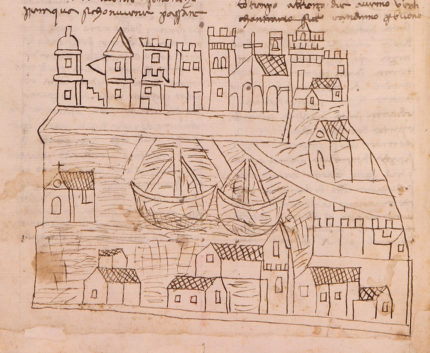A pen and ink drawing in a 14th century travelogue is the oldest known city view of Venice. The image was drawn by Niccolò da Poggibonsi, a Franciscan friar who made a pilgrimage to the Holy Land and Egypt in 1345-50, in his account of his travels now in the Biblioteca Nazionale Centrale in Florence. He wrote his travelogue the Libro d’oltramare, after his return to Italy. While the manuscript has been published before, the drawing has not. It was identified by Dr. Sandra Toffolo from the University of St Andrews’ School of History.
When Dr Toffolo discovered the image, she realised that the city view of Venice predates all previously known views of the city, excluding maps and portolan charts. The oldest extant map of Venice was made by Fra Paolino, a Franciscan friar from Venice, and dates from around 1330. Since the discovery, Dr Toffolo has spent the last several months verifying the image through consulting books, manuscripts and articles.
A series of small pinpricks discovered on the original manuscript image also suggests that the city view was more widely circulated. This technique was used to copy images: powder was sifted through the pinpricks onto another surface, thereby transferring the outlines of the image.
Dr Toffolo said: “The presence of these pinpricks is a strong indication that this city view was copied. Indeed, there are several images in manuscripts and early printed books that are clearly based on the image in the manuscript in Florence.
Niccolò left Poggibonsi in Tuscany in March of 1345 and went through Florence, Bologna, Ferrara, Chioggia before arriving in Venice. It’s the first city he writes about it in detail. Since his epic voyage was a pilgrimage, Venice gets air time for its many holy relics.
“In this city there are many saints’ bodies, like of Saint Mark the Evangelist, even though it’s not on display. But I saw the whole body of Saint Lucia and of Saint Zechariah, father of John the Baptist, whole and entire, and Saints Cosmas and Damian, and the foot of Saint Mary of Egypt, and saw the thigh bone of Saint Christopher and I measured it — it was from hip to knee four spans long — and other saints’ bodies did I visit.
But the city itself made a big impression with the traveler. The canal system even got its own chapter.
This is a noble city, and it sustains itself better as a community than any other place in the world, and all the men are merchants and the women work by hand, because every necessity of life they have to bring in from the outside for money. The reason is because Venice is all in the sea, has no land around it where they might harvest grain or other to live off of.
Regarding this land, meaning Venice, it is made differently from other places in that the whole city there are no streets on land. Their streets, small and large, are canals of water, and so by water, ie, by boat, one travels everywhere. […] And the city is full of beautiful houses with many bell towers that are so tilted that it seems they’ll fall from the bad foundations. They can’t make better ones because of the sea.
I think it is the most regal port in the world where you can always find ships to navigate anywhere in any country a man has business to visit.

The pinprick and powder technique of transferring a design is referred to as “pouncing.”
Good Friends,
Scott is correct. I’m not sure what tool was used in the middle ages, but “pounce wheels” have been used for years, including by the people who paint business names on glass doors. The tool looks like a small clock gear that turns on an axle at the end of a stylus about the size of a ballpoint pen. The teeth of on the wheel are VERY sharp and can cut through paper (or parchment), and even mark glass. Pounce wheels are still available in art supply stores.
Yours Aye,
Mungo Napier, Laird of Mallard Lodge SCA
(aka Garth Groff)
The ‘Exarchate of Ravenna’, was overseen by a viceroy (the “Exarchos”) appointed by the Emperor in Constantinople. Ravenna and Venice were connected only by sea route, and in 568, the Lombards under King Alboin had invaded Northern Italy.
In other words, I personally do not know by when the lagoon was inhabited, but in between the 6th and the 14th century is a whopping 1200 years, and therefore in some sort of Byzantine record in Istanbul (or elsewhere), there *might* be a description or some form of sketch :confused:
Albrecht Dürer develops some very early form of “camera” in his work on geometry (plus woodcut from from 1525), i.e. the “Four Books on Measurement” (his “Instructions for Measuring with Compass and Ruler”) in Bk. 4. (Also, note that the ‘camera obscura’ is even older):
——————–
[cf. his woodcut] “..let your apprentice pin up the needle with the thread in such manner, as for the essential pixels of the [to be captured] lute [on the table], whenever he captures and tensions the long thread, pinpoint the pixel coordinates with two perpendicular threads within the frame and then paint a dot where the pixel has been captured by the two perpendicular threads. Then, open the shutter again , and continue until all the essential pixels [of the lute on the table] have been dotted onto the board. Finally connect the dots with lines, and you will see what is developing out of it. In this manner, you also might want to copy other things.” 😆
——————–
How the skyline of Venice is to be “pinpricked” correctly, has been demonstrated by Giovanni Antonio “Canaletto” himself, who possibly used a ‘camera obscura’, i.e. -if so- he “pricked” all pixels through one single dot (pinhole image), ..and still would have to do the sketch.